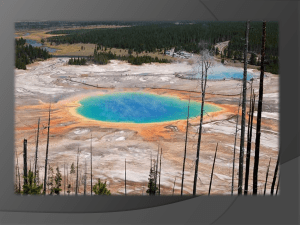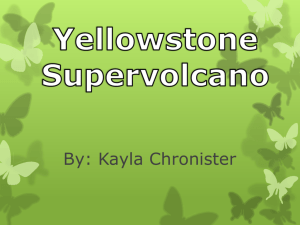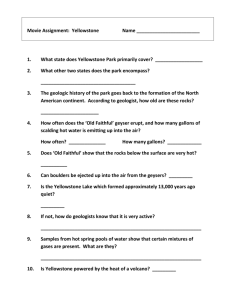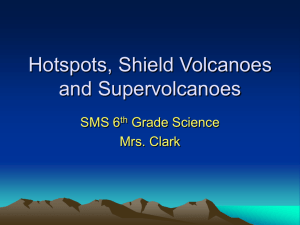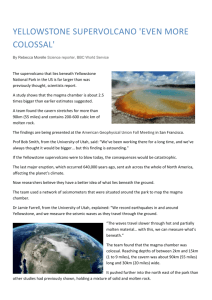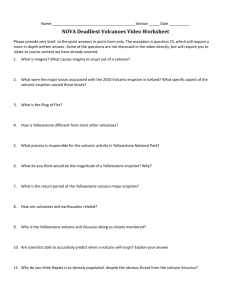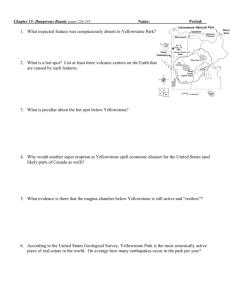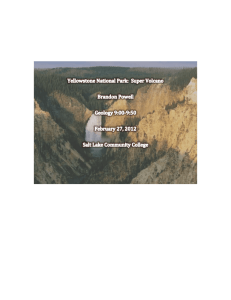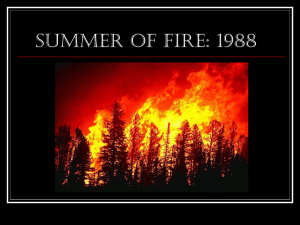Yellowstone Volcano Article
advertisement
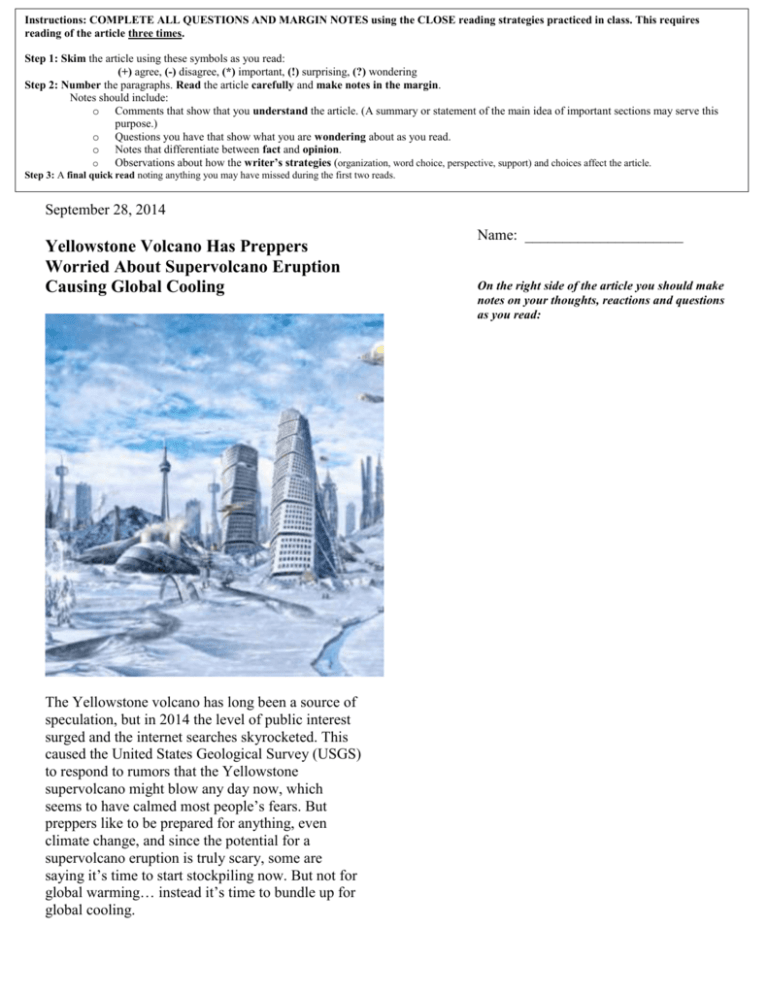
Instructions: COMPLETE ALL QUESTIONS AND MARGIN NOTES using the CLOSE reading strategies practiced in class. This requires reading of the article three times. Step 1: Skim the article using these symbols as you read: (+) agree, (-) disagree, (*) important, (!) surprising, (?) wondering Step 2: Number the paragraphs. Read the article carefully and make notes in the margin. Notes should include: o Comments that show that you understand the article. (A summary or statement of the main idea of important sections may serve this purpose.) o Questions you have that show what you are wondering about as you read. o Notes that differentiate between fact and opinion. o Observations about how the writer’s strategies (organization, word choice, perspective, support) and choices affect the article. Step 3: A final quick read noting anything you may have missed during the first two reads. Your margin notes are part of your score for this assessment. Answer the questions carefully in complete sentences September 28, 2014 Yellowstone Volcano Has Preppers Worried About Supervolcano Eruption Causing Global Cooling The Yellowstone volcano has long been a source of speculation, but in 2014 the level of public interest surged and the internet searches skyrocketed. This caused the United States Geological Survey (USGS) to respond to rumors that the Yellowstone supervolcano might blow any day now, which seems to have calmed most people’s fears. But preppers like to be prepared for anything, even climate change, and since the potential for a supervolcano eruption is truly scary, some are saying it’s time to start stockpiling now. But not for global warming… instead it’s time to bundle up for global cooling. unless otherwise instructed. Name: _____________________ On the right side of the article you should make notes on your thoughts, reactions and questions as you read: In a related report by The Inquisitr, it’s claimed that oil fracking could induce earthquakes, so The Inquisitr asked several scientists whether or not it’s possible that earthquakes induced by U.S. oil fracking could affect the Yellowstone supervolcano. Interestingly enough, it turns out that an alternative energy company is already hydro fracking a dormant volcano out west in hopes of siphoning off some of that geothermal energy being produced in mass quantities. But while these geothermal plants could generate alternative electricity, some people still may not like the idea since a recent study claims that living near a fracking site puts people in risk of developing lung and skin conditions. Still, most people don’t care too much about the debate over energy. The real concern is whether or not the Yellowstone supervolcano will blow in our lifetimes. It is true that about 60 volcanoes erupt each year all over the planet, which does sound kind of alarming at first glance. Even the USGS has previously estimated the annual odds of a Yellowstone volcano eruption being somewhere in the range of 730,000 to one. But leading expert Dr. Robert Smith is a little bit more conservative with his estimate, putting it closer to one million to one. Regardless of the odds, a writer for the PostIntelligencer posed the worst case scenario that any Doomsday Preppers fan might find interesting. “Scientists warn that it might not be long until a super volcano under Yellowstone Park erupts. By comparison, Mount St. Helens was a puff of smoke. In 1980, Mount St. Helens, in the State of Washington erupted. The eruption was the only significant one to occur in the lower 48 U.S. states since 1915. Two months of prior earthquakes and steam-venting episodes were warnings. A column of smoke rose 15 miles into the atmosphere and affected 11 U.S. states. Fifty-seven people died. Does Old Faithful in Yellowstone Park ring a bell? Something is going on there, and it is a scary thought.” Scary is probably an understatement. The USGS recently discussed a study where the ash distribution of a Yellowstone volcano eruption was modeled, and practically a good chunk of the American Midwest would be covered in black ash. But preppers prepare for everything, and in this case, a massive volcanic eruption could potentially trigger global cooling. “The problem would then become food, water, clean air, and warm clothes and shelters. Massive volcano dark clouds would shut out sunlight. Heavy dark clouds would reduce plant growth, and that would lead to food shortages for this country. There is no enforceable law when people are starving. Colder air would be another result, and clothing would necessarily be heavier with jackets, gloves, etc… The main point here isn’t a Yellowstone volcano eruption. The point is that the more we prepare for global cooling or the non-existent global warming, the better we can collectively meet threats.” Fortunately, this worst case scenario should not have anyone losing sleep over the matter. As of the beginning of September, the USGS has declared the Yellowstone volcano alert level as “normal,” and the seismic activity in the area continues to be high volume but relatively low in magnitude. 1. Would you consider Inquisitr.com a reliable source for this information? Provide specific evidence for your opinion. 2. Based on the on the context in which it is used in the article, what do you think the word prepper means? 3. What other environmental issue is creating people to worry about the Yellowstone Supervolcano? Explain how these two issues are related. 4. What are the odds that the Yellowstone volcano will erupt? 5. What similarities to our novel would there be in the consequences of the eruption of the Yellowstone supervolcano? Notes on my thoughts, reactions and questions as I read: 6. Describe the illustration provided in the article. What does the image depict, and how does this image enhance the text? What are the advantages and disadvantages of using images alongside text?
